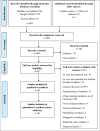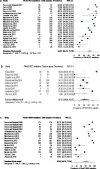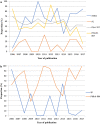Drug resistance markers within an evolving efficacy of anti-malarial drugs in Cameroon: a systematic review and meta-analysis (1998-2020)
- PMID: 33422080
- PMCID: PMC7796563
- DOI: 10.1186/s12936-020-03543-8
Drug resistance markers within an evolving efficacy of anti-malarial drugs in Cameroon: a systematic review and meta-analysis (1998-2020)
Abstract
Background: Malaria remains highly endemic in Cameroon. The rapid emergence and spread of drug resistance was responsible for the change from monotherapies to artemisinin-based combinations. This systematic review and meta-analysis aimed to determine the prevalence and distribution of Plasmodium falciparum drug resistance markers within an evolving efficacy of anti-malarial drugs in Cameroon from January 1998 to August 2020.
Methods: The PRISMA-P and PRISMA statements were adopted in the inclusion of studies on single nucleotide polymorphisms (SNPs) of P. falciparum anti-malarial drug resistance genes (Pfcrt, Pfmdr1, Pfdhfr, Pfdhps, Pfatp6, Pfcytb and Pfk13). The heterogeneity of the included studies was evaluated using the Cochran's Q and I2 statistics. The random effects model was used as standard in the determination of heterogeneity between studies.
Results: Out of the 902 records screened, 48 studies were included in this aggregated meta-analysis of molecular data. A total of 18,706 SNPs of the anti-malarial drug resistance genes were genotyped from 47,382 samples which yielded a pooled prevalence of 35.4% (95% CI 29.1-42.3%). Between 1998 and 2020, there was significant decline (P < 0.0001 for all) in key mutants including Pfcrt 76 T (79.9%-43.0%), Pfmdr1 86Y (82.7%-30.5%), Pfdhfr 51I (72.2%-66.9%), Pfdhfr 59R (76.5%-67.8%), Pfdhfr 108 N (80.8%-67.6%). The only exception was Pfdhps 437G which increased over time (30.4%-46.9%, P < 0.0001) and Pfdhps 540E that remained largely unchanged (0.0%-0.4%, P = 0.201). Exploring mutant haplotypes, the study observed a significant increase in the prevalence of Pfcrt CVIET mixed quintuple haplotype from 57.1% in 1998 to 57.9% in 2020 (P < 0.0001). In addition, within the same study period, there was no significant change in the triple Pfdhfr IRN mutant haplotype (66.2% to 67.3%, P = 0.427). The Pfk13 amino acid polymorphisms associated with artemisinin resistance were not detected.
Conclusions: This review reported an overall decline in the prevalence of P. falciparum gene mutations conferring resistance to 4-aminoquinolines and amino alcohols for a period over two decades. Resistance to artemisinins measured by the presence of SNPs in the Pfk13 gene does not seem to be a problem in Cameroon. Systematic review registration PROSPERO CRD42020162620.
Keywords: Anti-malarial drug; Cameroon; Efficacy; Malaria; Mutations; Plasmodium falciparum; Resistance; Systematic review.
Conflict of interest statement
The authors declare that they have no competing interests.
Figures







References
-
- WHO. World Malaria Report 2019. Geneva, World Health Organization. https://www.who.int/publications-detail/world-malaria-report-2019. Accessed on 8th December, 2019.
-
- Cameroon National Malaria Control Programme (NMCP). Annual report of activities 2006, Yaoundé, 2006.
-
- WHO. World Malaria Report 2008. Geneva, World Health Organization, 2008. http://www.who.int/malaria/publications/atoz/9789241563697/en/. Accessed on 10th August, 2017.
-
- Cameroon National Malaria Control Programme (NMCP). Annual report of activities 2016. Yaoundé, 2016.
Publication types
MeSH terms
Substances
Grants and funding
LinkOut - more resources
Full Text Sources
Other Literature Sources

